![]()
![]()
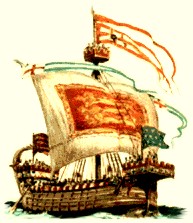
A
Y A
S
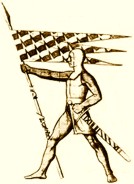
T H E G O L D E N P O R T
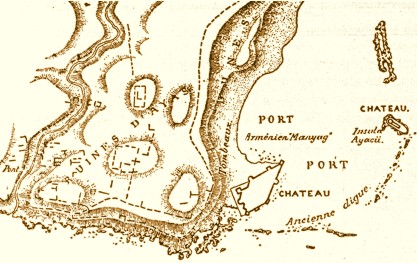
PLAN OF AYAS.
Written by Gevork Nazaryan
The portal City of Ayas, known as "the Golden port of Armenia" and "the port of many ships" was one of the biggest cities and a bustling center of international trade and commerce of Cilician Armenia. Documents, such as agreements, grants and trading treaties found in the archives of Genoa show the extent of trading agreements that existed between states such as France, England, Spain, Italy and City-States such as Genoa, Venice, Pisa, Florence, as well as eastern ties with Persia, India, China, Arabia and as well as many other cities and states from all over the world many of the Genoese and Venetian traders established themselves in the commercial districts of the city-port of Ayas and conducted businesses with traders from all over the world. These traders, in a decree issued as early as in the reign of King Levon II the Magnificent [1199 - 1219], had their own markets, their own clergy and were governed and judged under their own jurisdiction. The location of Ayas in of itself were of vital importance for the growth and expansion of the Kingdom. The revenue generated from Ayas, made up a large part of the total budget of the Armenian State. Precious goods such as carpentry, jewelry, wool, leather, precious stones, exotic metals, weaponry, dies, exotic spices and foods were imported and exported from the world renowned port of Ayas.
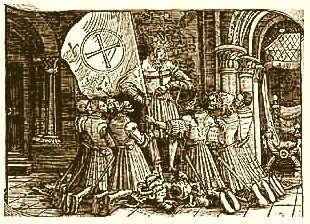
INITIATION INTO THE KNIGHTLY-MONASTIC SPIRITUAL ORDER
THE ARMENIAN KNIGHTS RALLIED AROUND THE SACRED BANNER AND
FOUGHT TO THE DEATH IN ORDER TO
DEFEND THE KINGDOM FROM FOREIGN INVADERS. AYAS FELL IN 1337 TO THE MAMLUK
INVADERS AFTER HEROIC RESISTANCE BUT THE CILICIAN KNIGHTS KEPT THE
RESISTANCE THROUGHOUT PARTS OF CILICIA WELL INTO THE XVTH AND EVEN XVITH
CENTURY WITH THE ALLIED GENOESE AND THE KNIGHTS HOSPITALLERS.

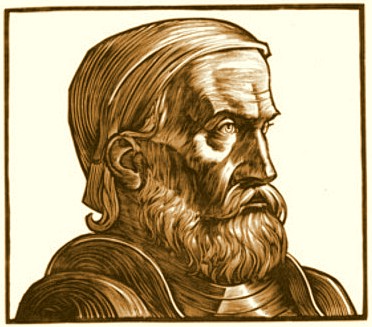
The Armenian Kingdom prided itself on its vast network of mercantilism which made Cilicia one of richest states of the period. Ayas formed the essential link for the prosperity and expansion of that network. The safeguarding and protection of the port was the primary goal of kings of Cilicia by the Rubinian, Het'umian and as well as Lusignan monarchs. The city also had an extensive vicinity of neighborhoods of artisans and craftsmen who created numerous beautiful artifacts of great elegance and luxury and as well as practical necessities of everyday use that were exported from the port of Ayas to the important commercial centers of the world.

ONE OF THE LETTERS OF KING LEVON THE MAGNIFICENT SENT TO
POPE INNOCENT III IN 1216 ATTACHED WITH THE OFFICIAL GOLDEN SEAL.
[SEE BOTH OBVERSE AND REVERSE BELOW]
THE LETTER IS ONE OF FEW PRESERVED EXEMPLARS THAT
HAS BEEN CONSERVED BY THE VATICAN DEPOSITORY.
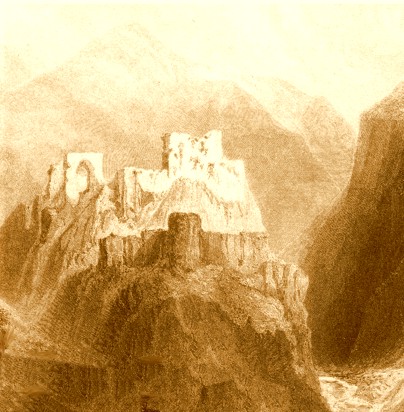
THE RUINS OF BAGHRAS CASTLE ON THE PEAKS OF IMPREGNABLE
MOUNTAINS.
THE CASTLE WAS ONE OF THE STRATEGICALLY IMPORTANT STRONGHOLDS
OF THE ARMENIAN KNIGHTS.
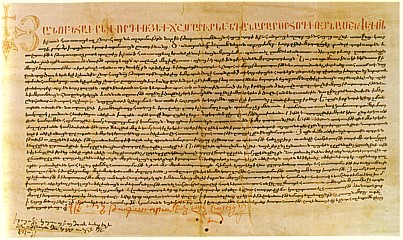
DECREE ISSUED BY LEVON V ON NOVEMBER 24, 1331 BEARING THE
SIGNATURE OF
THE KING. THE DECREE AUTHENTICATES THE GRANTING OF NUMEROUS RIGHTS
AND PRIVILEGES TO THE SICILIAN MERCHANTS. THE BEGINNING ARMENIAN LETTER
IS IN A FORM OF TWO DRAGONS FACING EACH OTHER UNITED BY A FLEUR DE LYS.
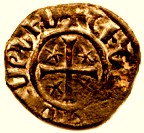
COIN OF KING OSHIN HETUMIAN [1308-1320]
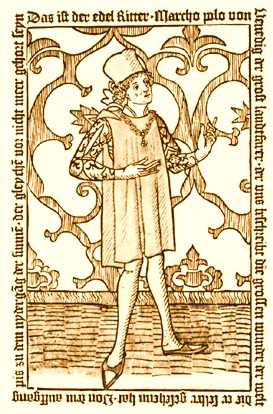
TITLE PAGE OF THE FIRST PRINTED EDITION OF THE TRAVELS OF
MARCO POLO, 1477.
(COLUMBIA UNIVERSITY LIBRARIES, NEW YORK). MARCO POLO RECOUNTED HIS
AMAZEMENT OF THE BEAUTY AND WEALTH OF ARMENIAN CITIES LIKE AYAS.
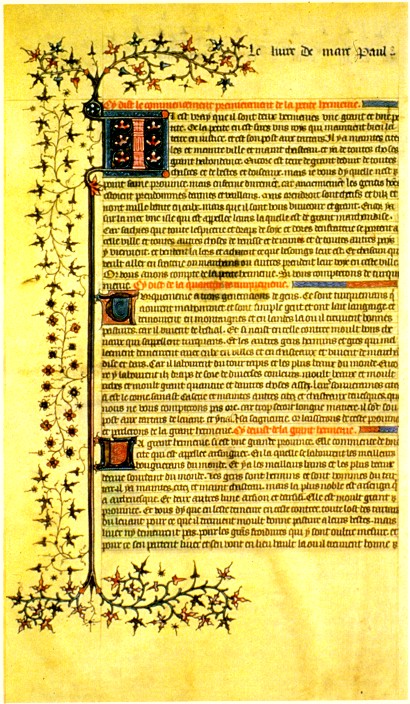
In the year 1271, the famous traveler Marco Polo, set sailed from Ayas home -- to Venice -- in an Armenian transport ship.
According to the renowned Venetian, in Ayas, one could acquire every type of spice, silken cloth, gold embroidered brocade and other goods, which were brought there from the Far East and Central Asia. Marco Polo also notes that during his time in the second half of the XIIIth century, Ayas was the usual point of departure for western European travelers on their way to and from the countries of the Far East. Russian furs that were in high demand in Europe during this period were being imported via the land route of Sudak-Sinop-Caesaria to the port of Ayas from where they were shipped to Europe. Another very important trading route on the Silk Road stretching from the Far East to Ayas and beyond to Europe was the Tabriz-Ayas highway. On the variety of items transported from Tabriz to Ayas and other cities, Manandian in Trade and Cities of Armenia:
The main items of export from Tabriz were spices, cubeb pepper, nard, cloves, nutmeg, ginger and cinnamon, precious stones, mainly turquoise and rubies, pearls, lapis-lazuli, the silk of the Caspian provinces, indigo, amber, musk, incense, costly cloths – taftah, zendado, buchermae, setunis, and others.
Marco Polo, spoke of Ayas, as “a city of good and great and of great trade” in his renowned book, The Description of the World, he wrote “The Armenians have a city on the sea, which is called Layas, where a great trade is carried on. Because, you must know, all sorts of spices, silken and gold-braided goods and other precious wares are brought from the interior to this city. The merchants of Venice and Genoa and other countries come to this place to sell and to buy goods. And whoever wishes to travel to the East, be he merchant or otherwise, sets out from this city of Layas.”
In A History of the Crusades, Sutton, Wolff, Hazard wrote: “Economic developments reflect this political evolution. Not that commercial activity declined prior to the fall of the Il-Khanid empire. On the contrary, the favorable conditions created by Mongol unification and toleration, and the development of western undertakings, created a current of exchange from Central Asia to the Mediterranean probably greater than before. But the direction of the carrying trade through Anatolia was thrown into confusion. The north-south trans-peninsular route across Anatolia toward Egypt via Adalia declined considerably, as did the drawing-power of the court of Iconium. The caravans now made for Trebizond, only touching a corner of the old Selchukid territory at Erzerum, or for Ayas in Cilicia. Despite political discord, however, trade continued between the north and south shores of the Black Sea, above all in Armenian and Italian hands. Sebastia therefore remained an important crossroads for international commerce. The more western areas, however, were forsaken, and meanwhile the dislocation of the Mongol empire likewise endangered the commerce of the eastern areas.”
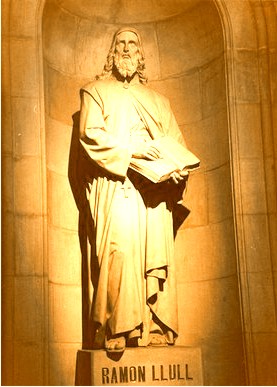
THE RENOWNED
PHILOSOPHER AND ALCHEMIST ['DOCTOR ILLUMINATUS']
FRANCISCAN RAMON LLULL [1232-1315] LIVED IN AYAS FOR SOME TIME IN
1302.
THE ARMENIAN KING HAD GIVEN INVALUABLE ALCHEMICAL TEXTS
FROM THE ROYAL LIBRARY TO THE ORDER OF ST. JOHN EARLIER IN XIIITH CENTURY.
Victor Langlois, a prominent XIXth century Armenologist rightly noted: "Numerous are those events, those brilliant traditions, however lamely we may follow the course of Armenia's victories and progress, however hastily we may examine the organization of her aristocracy and clergy, however slightly we may study her relations with the Western nations, and the wars which she waged against, the Turks, still shall we see that the historical documents of this country, contain the memories of a glorious past."
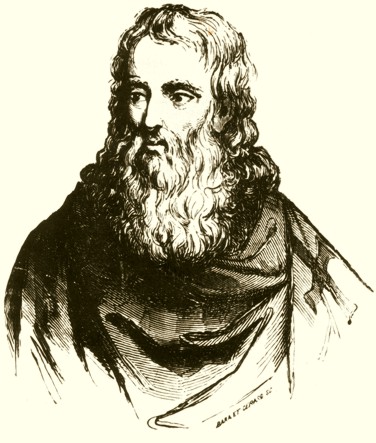
NERSES THE GRACIOUS WEARING THE CAPE WITH THE
EMBLAZONED RED CROSS ON HIS LEFT ARM.
HE IS RENOWNED FOR NUMEROUS SUBLIME WORKS
INCLUDING HIS MAGNUM OPUS --
LAMENT OF EDESSA [URHAI-ORION...]
WHEN THE CITY FELL TO THE TURKS AFTER
MONTHS OF HEROIC DEFENSE BY ARMENIAN
KNIGHTS AND CRUSADERS.
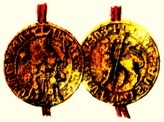
THE GOLDEN SEAL OF KING HET'UM I.
REPLICA OF THE TAGAVORAKAN COIN.
THE CILICIAN GOLD AND SILVER TAGAVORAKANS DURING THIS
PERIOD WERE
CHOSEN OVER THE WIDELY CIRCULATED VENETIAN DUCAT.
THE TAGAVORKAN REMAINED THE ACCEPTED CURRENCY
FOR BUYING AND SELLING BY THE MERCANTILE TRADERS
THROUGHOUT THE MEDITERRANEAN WORLD.
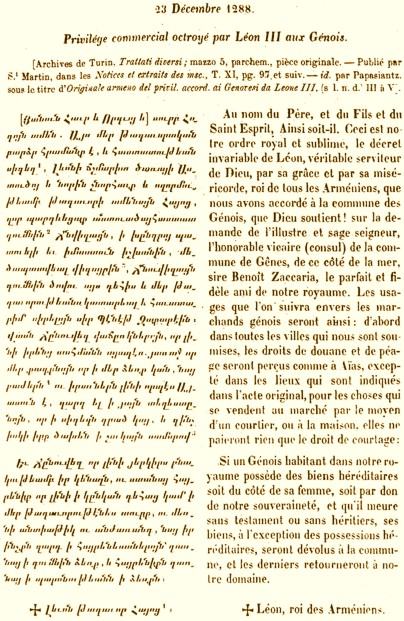
A CHARTER BY KING LEVON III ISSUED ON DECEMBER 23, 1288 TO
GENOESE
TRADERS. FROM VICTOR LANGLOIS [REPRINTED BY ARMEN GHAZARIAN], 1863.
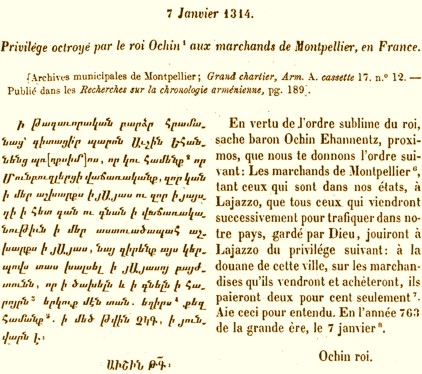
KING OSHIN'S TREATY ISSUED ON JANUARY 7, 1314 GRANTING SPECIAL
PRIVILEGES
TO THE MERCHANTS OF MONTPELLIER IN AYAS.
FROM VICTOR LANGLOIS [REPRINTED BY ARMEN GHAZARIAN], 1863.
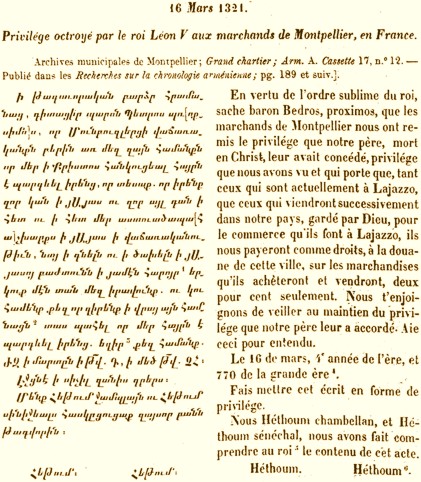
KING HET‛UM'S TREATY ISSUED
ON MARCH 16, 1321 GRANTING SPECIAL
PRIVILEGES TO THE MERCHANTS OF MONTPELLIER IN AYAS.
FROM VICTOR LANGLOIS [REPRINTED BY ARMEN GHAZARIAN], 1863.

DUTY. HONOR. COURAGE.

FIRST SEAL OF BÉZIERS.
LANGUEDOC, 1226. ARCHIVES NATIONALES.
ENCIRCLING INSCRIPTION READS: COMVNE CIVITATIS BITERRICENSIVM.
CATHAR KNIGHT ON HORSEBACK WEARING A CONICAL HELMET, MAIL COAT,
A SWORD IN ITS SCABBARD, A LANCE WITH PENNANT IN ITS REST,
HIS SHIELD AND HORSE'S COVERING BEARS ARMS.
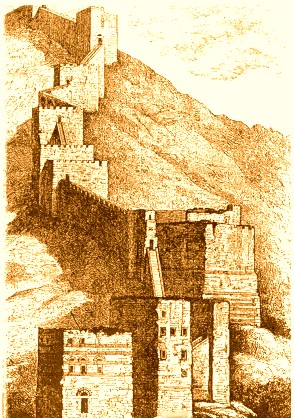
A SECTION OF THE OUTER WALLS OF ANTIOCH. THE
FORTIFICATIONS ENCLOSED
A LARGE AREA OF OPEN BEYOND THE BUILT UP AREA OF THE CITY PROPER.
THE MASSIVE MASONRY PROVIDED A FORMIDABLE OBSTACLE FOR ATTACKERS.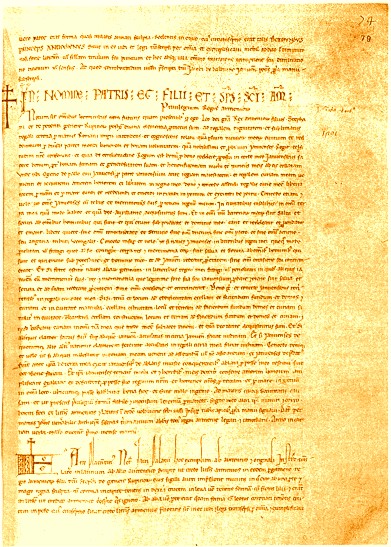
FIRST PAGE OF THE DECREE ISSUED IN MARCH OF 1201 BY KING
LEVON II
THE MAGNIFICENT TO THE GENOESE MERCHANTS GRANTING NUMBER OF
SPECIAL RIGHTS AND PRIVILEGES TO THE MERCHANT COMMUNITIES
THROUGHOUT CILICIAN ARMENIA, ESPECIALLY IN THE CAPITAL CITY OF SIS.
LATIN TRANSLATION MANUSCRIPT OF THE ORIGINAL ARMENIAN
DOCUMENT FROM 1267.

SECOND PAGE OF THE ABOVE MANUSCRIPT ISSUED BY LEVON THE
MAGNIFICENT
WITH THE PERSONAL ROYAL RED SIGNATURE OF THE KING: 'LEO KING OF
ARMENIANS' ALONG WITH PAPAL AND GENOESE INSIGNIA.
GENOESE STATE ARCHIVES. LIBER IURIUM VII, FOLIOS 74 AND 74v.

DECREE ISSUED IN DECEMBER OF 1201 BY KING LEVON II THE
MAGNIFICENT TO
THE VENETIAN MERCHANTS GRANTING NUMBER OF SPECIAL RIGHTS AND PRIVILEGES
TO THE MERCHANT COMMUNITIES THROUGHOUT CILICIAN ARMENIA. WITH THE
APPROVAL OF THE GRAND CHANCELLOR JOHN [LATER CATHOLICOS] OF CILICIAN
ARMENIA. LATIN TRANSLATION MANUSCRIPT OF THE ORIGINAL ARMENIAN
DOCUMENT. VENETIAN STATE ARCHIVES. LIBER PACTORUM II, FOLIO 6.
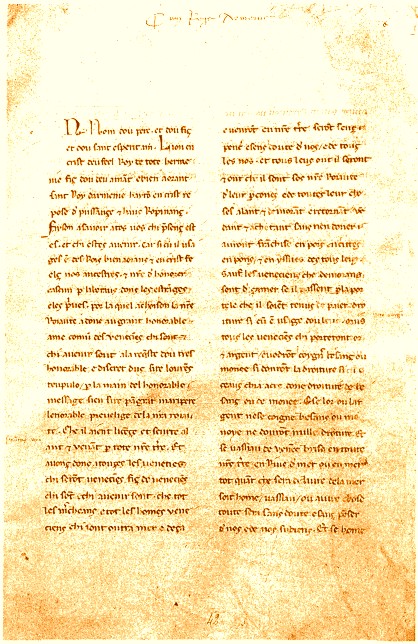
DECREE ISSUED IN JANUARY OF 1271 BY KING LEVON III TO THE
VENETIAN
MERCHANTS GRANTING NUMBER OF SPECIAL RIGHTS AND PRIVILEGES
TO THE VENETIAN MERCHANTS THROUGHOUT CILICIAN ARMENIA.
FRENCH TRANSLATION MANUSCRIPT OF THE ORIGINAL ARMENIAN DOCUMENT.
THE ORIGINAL ARMENIAN MANUSCRIPT WAS SEALED WITH THE RED THREAD
AND THE GOLDEN SEAL OF KING LEVON III AND UNDERSIGNED BY JEFFROY
THE FRANKISH CHANCELLOR OF CILICIAN ARMENIA.
VENETIAN STATE ARCHIVES. LIBER PACTORUM III, FOLIO 41.
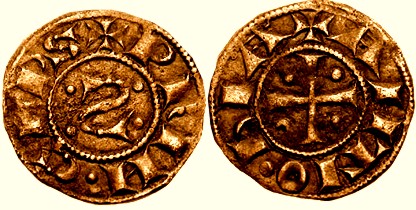
COIN FROM ANTIOCH [1149-1163] WITH REVERSED 'S' WITH FOUR
PELLETS.
EQUAL ARM CROSS [SUN] WITH THREE PELLETS [TRIUNE] AND CRESCENT [MOON].

THE COIN/SEAL OF BOHEMUND III [1163-1201] OF PRINCIPALITY
OF
ANTIOCH. HELMETED AND MAILED BUST LEFT; CRESCENT BEFORE
STAR BEHIND. CROSS PATTÉE; CRESCENT IN
SECOND QUARTER.

THE COIN/SEAL OF BOHEMUND IV [1201-1232] OF PRINCIPALITY
OF
ANTIOCH. HELMETED AND MAILED BUST LEFT; CRESCENT BEFORE
STAR BEHIND. CROSS PATTÉE; CRESCENT IN
SECOND QUARTER.

THE COIN/SEAL OF PRINCE RAYMOND RUBEN [1216-1219] SON OF
LEVON THE MAGNIFICENT. LEADER OF ALLIED ARMENIAN-CRUSADER
PRINCIPALITY OF ANTIOCH. HELMETED AND MAILED BUST LEFT; CRESCENT
BEFORE PENTAGRAM BEHIND. CROSS PATTÉE;
CRESCENT IN SECOND QUARTER
[SUN AND MOON...].

GENERAL PLAN OF GERGER FORTRESS.
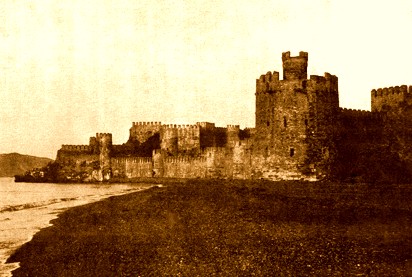
THE CASTLE OF ANAMOUR WAS ONE OF THE OUTLYING DEFENDING
OUTPOSTS OF
THE GOLDEN PORT.
The Armenian garrison of Ayas, 600 strong, twice repulsed the army of Sultan Nassir. On another occasion 200 Armenian warriors, in charge of the defense of a defile in the Amanus, entrapped 18,000 Seljuk Turks and crushed the foreign invaders. Prince Liparit led the Armenian knights in driving the marauding Turks out of Cilician Armenia. The Prince's name alone spread terror and fear among the Seljuks. After the fall of the Cilician Kingdom in 1375, the great city-port of Ayas fell under the rule of first Mamluks and later on Turkomans.
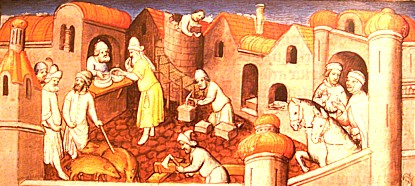
THE GOLDEN PORT OF AYAS. MANUSCRIPT ILLUMINATION FROM
LE LIVRE DES MERVEILLES. MARCO POLO SAILED FROM VENICE TO AYAS TO
CONTINUE
HIS JOURNEY ON HORSEBACK TOWARDS THE FAR EAST. HIS DESCRIPTION OF CILICIAN
AND GREATER ARMENIAS ARE STILL SOME OF THE MOST DETAILED
EYEWITNESS ACCOUNTS OF ARMENIA FORM THE MIDDLE AGES.
XIIITH CENTURY CONTRACTS CONNOTING SPECIAL
RIGHTS AND PRIVILEGES
GRANTED BY THE CROWN TO GENOESE MERCHANTS TO UNDERTAKE THEIR
COMMERCIAL ENDEAVORS IN AYAS. FROM THE STATE ARCHIVES OF GENOA.
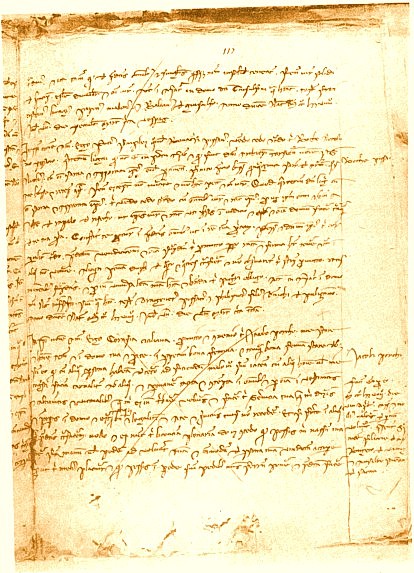
STATE ARCHIVES OF GENOA. NOTARY PIETRO DI BARGONE (cart. n. 53,
c. 117 r.)
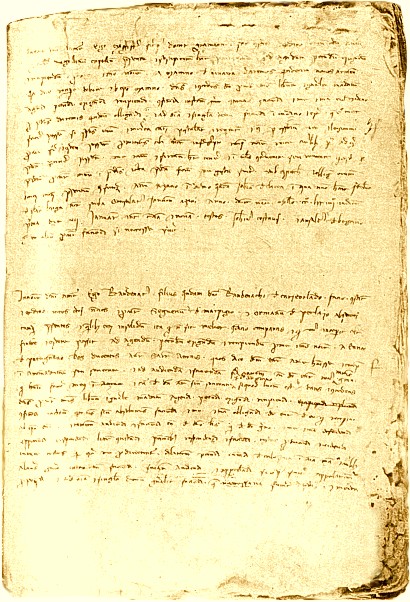
STATE ARCHIVES OF GENOA. NOTARY FEDERICO DI PIAZZALUNGA (cart. n.
121, c. 96 r.)
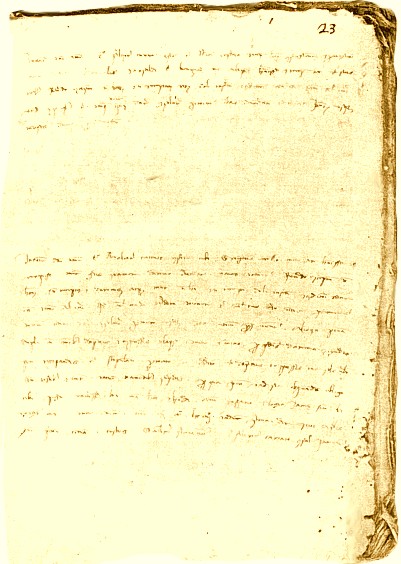
STATE ARCHIVES OF GENOA. NOTARY FEDERICO DI PIAZZALUNGA (cart. n.
111, c. 23 r.)
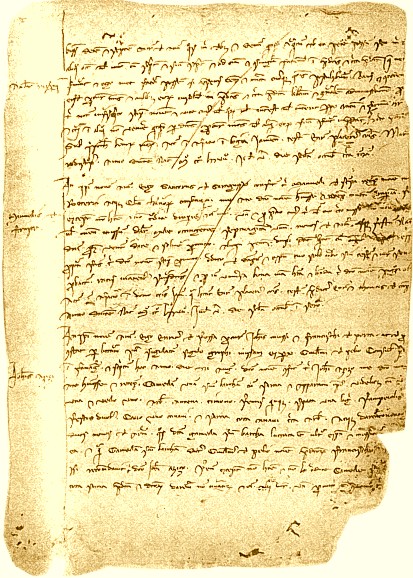
STATE ARCHIVES OF GENOA. NOTARY PIETRO DI BARGONE.
(Notai Ignoti, busta 14, frammento 128, c. 9 v.)

THE DISASTER AT MARI. ON AUGUST 24, 1266, THE MAMLUKS WERE
ABLE TO
SCORE A VICTORY AGAINST THE ARMENIAN FORCES AT MARI [NEAR DARBSAK]
KILLING ONE OF THE
SONS OF KING HET‛UM I [PRINCE T‛OROS]
AND CAPTURE THE CROWN
PRINCE [OTHER BROTHER] WHO WAS LATER RANSOMED AND WAS TO
BECOME KING LEVON III. THE NEW KING WOULD RESTORE THE HONOR OF HIS
HOUSE AND THE CROWN WITH A SERIES OF VICTORIES AGAINST THE
MAMLUKS DURING 1280s.

KING HET‛UM II IN 1303
ORGANIZES A JOINT ARMENO-MONGOL MILITARY
CAMPAIGN WITH IL-KHAN GHAZAN AGAINST THE MAMLUK INVADERS.
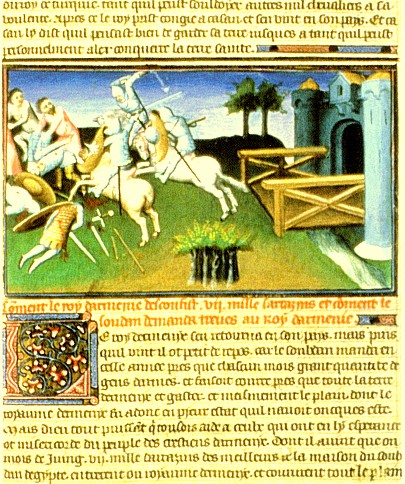
ARMENIAN VICTORY AT THE GATES OF AYAS IN 1305. ARMENIAN
KNIGHTS CHASE
THE MAMLUK REMNANTS TOWARDS ALEPPO. THE CHRONICLER RECORDED THAT
'A FORCE OF 7,000 SARACENS HAD ENTERED ARMENIA' AND ONLY 300 MANAGED TO
FLEE FROM THE BATTLEFIELD AT AYAS.
The great city for a brief period, in the beginning of the XVIth century was liberated by the Venetian Republic [during this period a number of independent Armenian strongholds were still holding out against the enemy in the highlands of Cilician -- in impregnable mountainous communities such as the aristocracy of the Black Mountains and Zeytun that were still in Armenian hands and were defended for more than a century after the fall of the Kingdom by the Armenian nobles] only to be lost later on by the overwhelming forces of the Ottoman Turks.

A XIXTH CENTURY ENGRAVING OF A PORTION OF THE
OUTER WALLS OF THE HARBOR OF AYAS.
